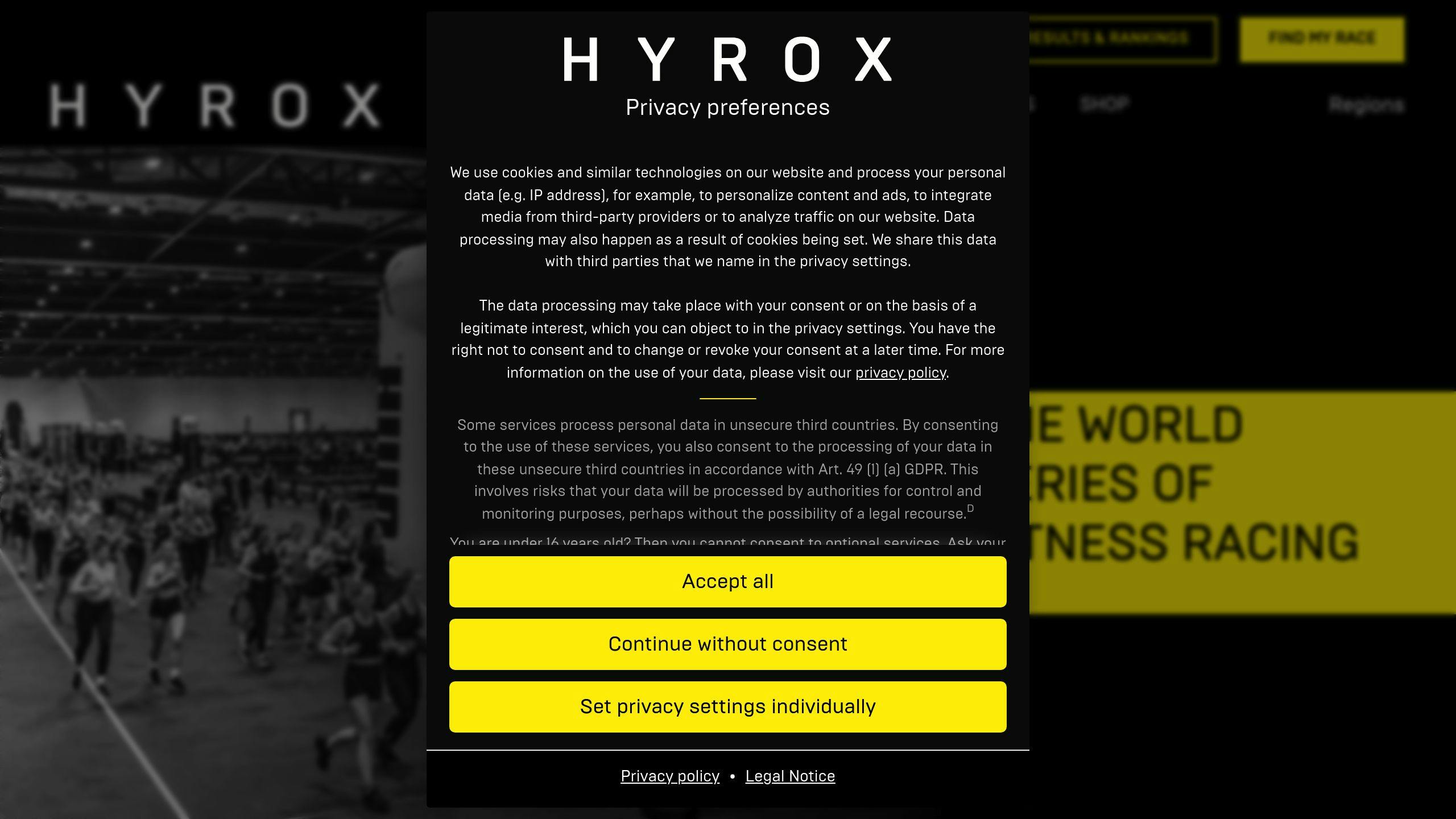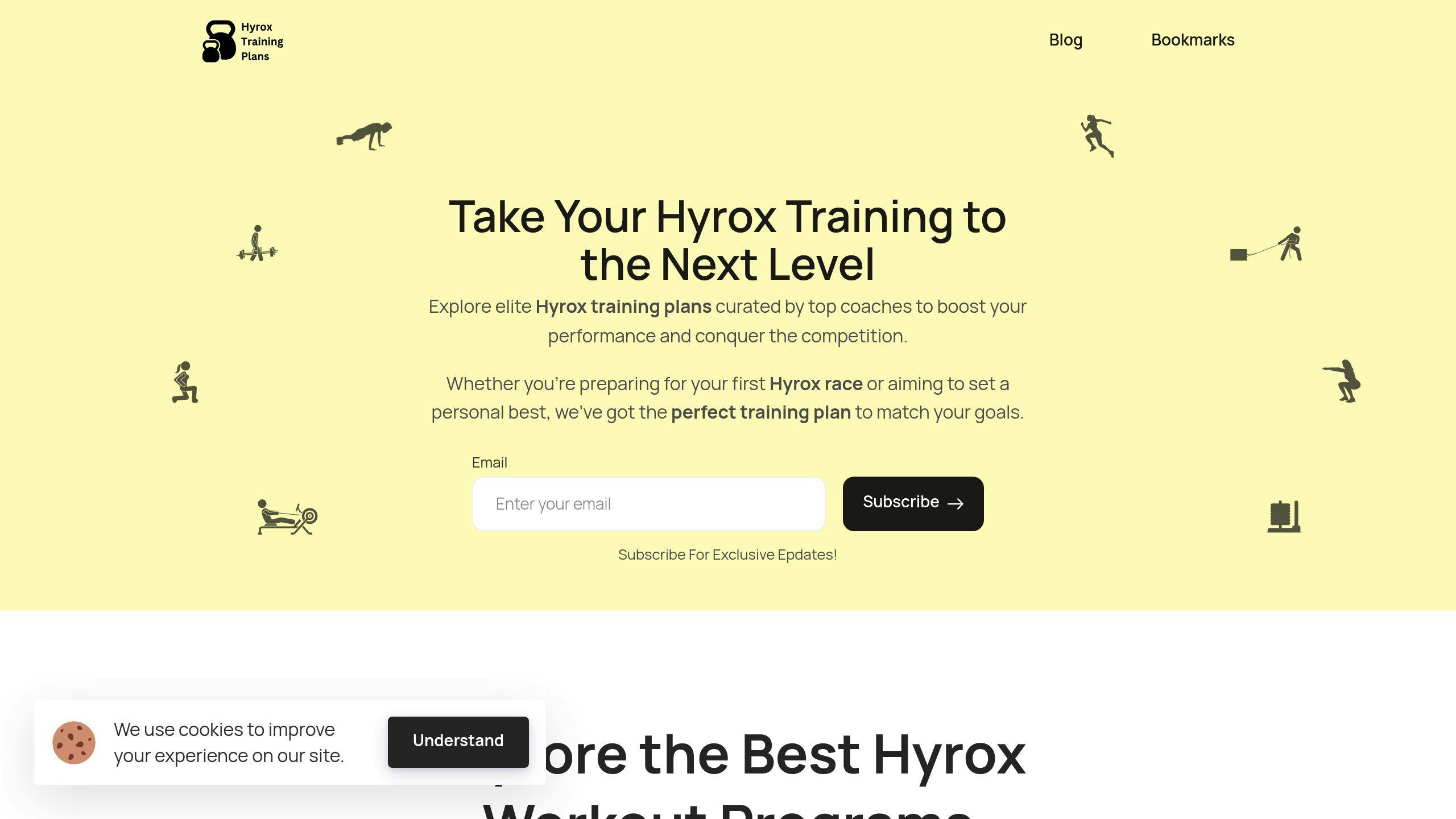Using feedback effectively can help you run faster, complete exercises more efficiently, and recover quicker. Here's how to make it work for your Hyrox training:
- Self-assessment: Track running times, station performance, and recovery metrics using apps, video analysis, and heart rate monitors.
- Coaching: Work with a coach for personalized plans, technique refinement, and race strategies.
- Group training: Train with others to stay motivated, share tips, and get fresh perspectives.
- Event feedback: Review your race performance to identify areas for improvement.
- Adjust training: Use feedback to tweak workouts, focus on weak areas, and reassess every 4-6 weeks.
Structured plans like Hyrox Training Plans include tools for regular assessments, video reviews, and progress tracking to help you improve faster and smarter. Feedback isn't just helpful - it's essential for Hyrox success.
Self-Assessment: Evaluating Your Hyrox Progress

Tracking Key Metrics
Mike Harrington, Head Coach at Hyrox Training Academy, emphasizes:
"Self-assessment is the cornerstone of continuous improvement in Hyrox training. It allows athletes to identify weaknesses, track progress, and make data-driven decisions about their training focus."
To stay on top of your progress, focus on these key metrics:
| Metric Type | What to Track | How to Measure |
|---|---|---|
| Running Performance | 1km split times, pace consistency | GPS watch, smartphone apps |
| Station Performance | Exercise completion times, rep quality | Stopwatch, video analysis |
| Recovery Metrics | Heart rate zones, rest periods | Heart rate monitor, manual tracking |
Once you’ve collected this data, video analysis can help you refine your performance even further.
Refining Technique Through Video Analysis
Using video to analyze your technique is a game-changer. Here’s how to make the most of it:
- Record yourself from different angles (front, side, back).
- Use slow-motion to compare your form to professional athletes.
- Focus on maintaining good form, especially when fatigued.
These visual insights provide a clear picture of areas needing improvement, which you can document in your training journal.
Maintaining a Training Journal
A well-kept training journal blends hard data with personal observations. Include these elements:
| Component | Key Elements |
|---|---|
| Workout Details | Sets, reps, weights |
| Performance Data | Split times, duration |
| Recovery Metrics | Sleep quality, soreness |
| Mental Notes | Energy levels, motivation |
This structured approach ensures that every workout contributes to your overall progress. It also ties into the feedback strategies discussed earlier, creating a loop of continuous improvement.
External Feedback: Insights from Coaches and Peers
Why Work with a Hyrox Coach?
According to data from Hyrox Training Plans, athletes who follow structured coaching see performance improvements 18% faster than those training on their own. Coaches bring a lot to the table, including:
- Technique refinement: Detailed analysis of movement, breaking down station techniques frame by frame.
- Performance tracking: Monitoring times for each station and recovery metrics.
- Customized training plans: Adjustments based on individual strengths and weaknesses.
- Race strategies: Guidance on pacing and managing fatigue effectively.
While one-on-one coaching provides personalized insights, group training offers added accountability and motivation through peer support.
The Role of Group Training and Communities
Training in a group setting can create a highly motivating and productive atmosphere. In fact, 92% of Hyrox participants in group environments report feeling more motivated and accountable.
To get the most out of group training:
- Rotate partners to gain fresh perspectives.
- Record and review techniques to spot areas for improvement.
- Share strategies and feedback after sessions to refine approaches.
Using Event Feedback to Improve
Hyrox competitions are a goldmine for learning and refining your training. Hyrox Training Plans use these performance indicators to adjust future programs:
- Station times: Compare how your times stack up against training benchmarks.
- Heart rate data: Analyze heart rate zones during critical stations.
- Movement efficiency: Look at details like sled push foot placement to spot inefficiencies.
Within 24 hours of your race, jot down any challenges you faced at specific stations and how your energy levels fluctuated. These notes will directly shape the training adjustments covered in the next section.
Elite Hyrox Performance Training: Feedback and Evolution
sbb-itb-8bcd5e0
Using Feedback to Adjust Training
Once you've gathered feedback - whether from self-assessment or external sources - it's time to put it to use. Here's how you can refine your training effectively:
Modifying Workouts Based on Feedback
Research shows that athletes who adjust their training based on feedback can improve 15-20% faster. The key is to analyze feedback carefully and make precise changes while keeping your overall routine balanced.
For example, if you struggle with slow sled pushes, consider these adjustments:
- Increase volume by 20%
- Add resistance exercises for legs and core
- Incorporate technique drills into warmups
- Track heart rate recovery between sets
Focusing on Weak Areas with Drills
Addressing specific weaknesses is crucial for progress. Use targeted drills to improve problem areas. Here's a quick guide:
| Weakness Area | Recommended Drill | Frequency | Progress Indicator |
|---|---|---|---|
| Wall Balls | Wall ball breakdowns focusing on squat depth | 2x weekly | 23% improvement in 8 weeks (avg) |
| Rowing Efficiency | Technique-focused intervals with power tracking | 3x weekly | Consistent power output |
| Running Economy | Post-strength endurance intervals | 2x weekly | Faster heart rate recovery |
"The ability to adapt your training based on feedback is what separates good Hyrox athletes from great ones. It's not just about working hard, but working smart and responding to what your body and performance are telling you." - Chris Hinshaw, Endurance Coach
Reassessing and Updating Training Plans
Top Hyrox athletes reassess their training every 4-6 weeks using performance data [2]. Programs like Hyrox Training Plans make this easier by including regular checkpoints.
Here's a simple review process to follow:
- Conduct monthly full-body assessments
- Track weekly recovery metrics
- Perform benchmark tests twice a month
- Hold monthly progress reviews
- Keep a journal to note energy levels and patterns
Use tools like performance trackers to guide adjustments. This ensures your changes are based on measurable data, not just gut feelings.
Using Structured Hyrox Training Plans for Feedback

Why Choose Structured Training Programs?
Structured Hyrox training programs offer a clear, step-by-step method to improve performance and incorporate feedback effectively. Research shows that athletes using these programs improved their race times by an average of 12% compared to those training on their own [1]. These plans go beyond self-assessment by including professional tools such as:
Built-in Assessment Tools
- Regular tests to track progress
- Heart rate monitoring for detailed analysis
- Dashboards to visualize improvements over time
Planned Progression Structured programs reduce training-related injuries by 25% [2], thanks to their focus on gradual and data-informed progress.
Key Features of Hyrox Training Plans
Hyrox Training Plans are designed to help athletes make the most of feedback and boost their performance. Here’s what they offer:
| Feature | Purpose | Benefit |
|---|---|---|
| Video Analysis | Weekly technique reviews | Quick form corrections |
| Progress Dashboard | Tracks performance metrics | Enables data-based adjustments |
| Periodization Cycles | Gradual intensity changes | Perfect timing for peak form |
| Station-specific Training | Focuses on weak areas | Prepares you for race day |
"Structured Hyrox training plans are essential for consistent progress. They provide the right balance of intensity, recovery, and skill development that's hard to achieve on your own." - Mike Trott
These plans also allow for tailored programming based on your skill level, with regular benchmarks to measure improvement. Recovery tracking features like heart rate monitoring and sleep analysis ensure a well-rounded approach to training.
When paired with effective feedback strategies, these plans create a powerful system for improving performance.
Conclusion: Improving Hyrox Performance with Feedback
Using the feedback strategies discussed earlier, Hyrox athletes can significantly improve their training and performance. Feedback is a powerful tool that should be a key part of any athlete's routine.
Practical Steps for Hyrox Athletes
Here’s how to effectively incorporate feedback into your training:
| Feedback Type | How to Implement | What You’ll Gain |
|---|---|---|
| Self-Assessment | Keep daily training logs and review biweekly videos | Better technique and form |
| Coach Input | Schedule monthly reviews and technique sessions | Focused skill improvement |
| Performance Data | Conduct benchmark tests every 4-6 weeks | Track measurable progress |
To get the most out of your training, prioritize refining your technique through video reviews, monitor your progress with structured plans, and use recovery insights from biometric data.
For a more streamlined approach, tools like Hyrox Training Plans offer structured programs that include built-in feedback systems. These programs help you stay on track with regular assessments and data-driven updates, ensuring steady growth over time.



